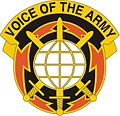Mission
NETCOM plans, engineers, installs, integrates, protects and operates Army Cyberspace, enabling Mission Command through all phases of Joint, Interagency, Intergovernmental and Multinational operations. Additionally, the commanding general is designated as the Deputy Commanding General for Network Operations, U.S. Army Cyber Command. With the headquarters at Fort Huachuca, Arizona, the NETCOM Team has nearly 16,000 Soldiers, Department of the Army Civilians and Contractors stationed and deployed in more than 22 countries around the world, providing direct and indirect support to Army, Joint and Coalition forces.
History
U.S. Army Strategic Communications Command
On 1 February 1945, the 9423rd Technical Services Unit - War Department Signal Center was organized at the Pentagon in Virginia. [1] Two years later, it was redesignated the U.S. Army Command and Administrative Communications Agency by the War Department. The title was simplified to the U.S. Army Communications Agency (ACA) in 1957. On 1 April 1962, the Army Communications Agency merged with the U.S. Army Signal Engineering Agency to form the U.S. Army Strategic Communications Command, (USASTRATCOM). The command was "charged with the engineering, installation, operation and maintenance of the Army’s portion of the Defense Communications Agency’s global communications network." [2] In December 1962 the Command became the Army proponent for the newly-established National Communications System.
On 1 March 1964 the office of Chief Signal Officer of the United States Army was abolished. His remaining operational responsibilities were assigned to the previously existing Class II activity, the US Army Strategic Communications Command (STRATCOM). STRATCOM was elevated into a major command to exercise full control over worldwide strategic communications. [3] It was commanded by a major general. The strategic communications command installed, maintained, and operated all the Army's long-distance networks, which it took over from the chief signal officer. [4] It also absorbed the Joint Communication Agency at Fort Richie, Maryland, the US Army Interagency Communications Agency at Winchester, Virginia, the US Army Signal Radio Propagation Agency at Fort Monmouth, New Jersey, and the US Army Signal Communications Security Agency.
The first subordinate command USSTRATCOM formed was STRATCOM-Europe, established 1 July 1964, in Schwetzingen, West Germany. STRATCOM-Europe absorbed 22nd and 106th Signal Groups and other communications responsibilities from USAREUR. By the end of 1965, all USAREUR communications duties, and even the position of USAREUR Deputy Chief of Staff for Communications–Electronics, had been transferred to STRATCOM-Europe. Changes in signals/military communications continued through the 1970s; 7th Signal Brigade was activated in 1970 from assets of the deactivated Seventh Army communications command. STRATCOM-Europe assumed operational control of the brigade in June 1972 and was redesignated as Army Communications Command-Europe (ACC-E) in October 1973. The 106th and 516th Signal Groups were also inactivated during this time and replaced by the 4th Signal Group.
STRATCOM established the 1st Signal Brigade to exercise command and control over all Army communications-electronics resources in Southeast Asia. Scattered among 200 sites in Vietnam and Thailand, this brigade became the largest combat signal unit ever formed. One of those units (formed in April 1969 until July that year), aided in the installation of modern communications equipment in Bang Phi, Thailand; improving the information networks for Southeast Asia.
U.S. Army Communications Command
STRATCOM leaders moved to modify the command's designation to better suit its changing mission by dropping "strategic" from its organizational title. On 1 Oct. 1973, the Army re-designated STRATCOM as the U.S. Army Communications Command (USACC).
After "the U.S. Army entered the aviation field, [USACC] assumed the air traffic control (ATC) mission. This mission included traffic control, on-site navigation aids maintenance, support maintenance, and antennae maintenance." The mission remained in place until 1986. [5] That year, with the creation of the United States Army Aviation Branch, all of the four missions were reassigned except for antennae maintenance. "The 7th Signal Command, who owned the antennae teams, continued to provide this service."
During the early 1980s, Army automation focused on the development of hardware and software systems. These systems were used for force development, personnel, supply, payroll, medical, maintenance, and troop support. Due to the scale of the work, the Army empowered USACC to lead development of strategic concepts for information systems management. USACC recommendations, combined with an Army Chief of Staff vision of consolidated information disciplines, gave genesis to the U.S. Army Information Systems Command (USAISC), the newest iteration of Fort Huachuca's strategic communications organization, on 1 May 1984.
Downsizing after the Cold War
Post Desert Storm Army downsizing and organizational review focused a critical eye on command structure. A general perception in the 1990s among major commands and theater commanders held that USAISC central management deprived them of needed command and control over regional and theater information systems, computer system acquisitions, and signal assets. The Department of the Army agreed and moved to dismantle USAISC, relegating the organization to major subordinate command status under U.S. Army Forces Command, and re-designating it as U.S. Army Signal Command (USASC) in September 1996.
U.S. Army Signal Command
Army MACOMs and theater commanders worked independently to resource their own Information System requirements. This decentralization and deregulation led to a proliferation of non-standardized command, control, communications, and computer (C4) systems and an unacceptable level of incompatibility among Army-wide communications equipment and support networks.
The department of the Army on 1 Oct. 2002, decided to again centralize service C4 and many aspects of information systems management and security under one Army command: the U.S. Army Network Enterprise Technology Command (NETCOM), reporting directly to the Army's Cyber Command (ARCYBER).
Mobile and Expeditionary Network
The Network cross-functional team (CFT) and the Program Executive Office Command, Control, Communications—Tactical (PEO C3T) hosted a forum on 1 August 2018 for vendors to learn what might function as a testable/deployable Army Network in the near future. [6] A few of the hundreds of white papers from the vendors, adjudged to be 'very mature ideas', were passed to the Army's acquisition community, while many others were passed to CERDEC for continuation in the Army's effort to modernize the network for combat. [7] In 2018, the brigades are transitioning from at-the-halt Tactical Network Transport to on-the-move systems. [8]
This page is based on this
Wikipedia article Text is available under the
CC BY-SA 4.0 license; additional terms may apply.
Images, videos and audio are available under their respective licenses.



